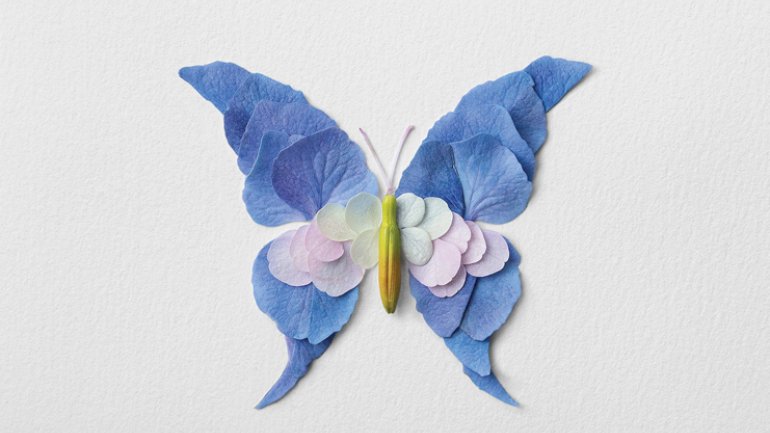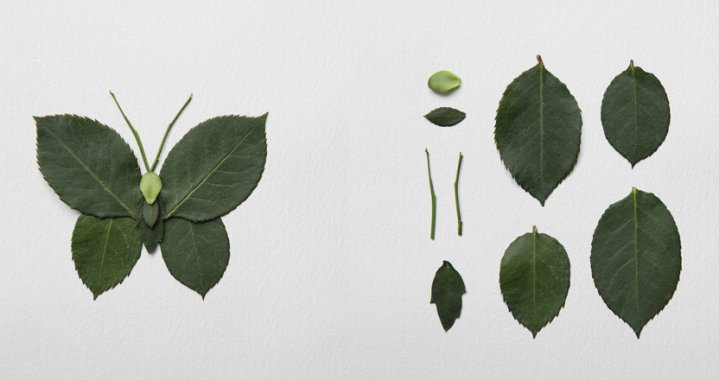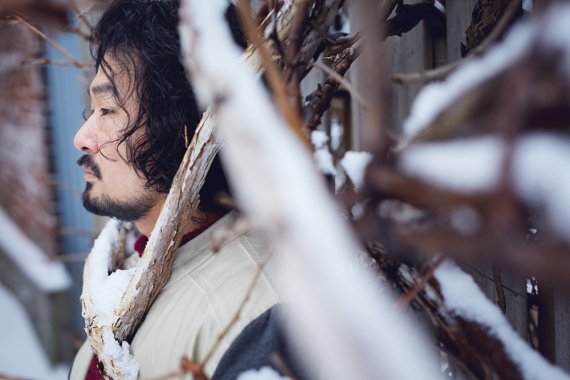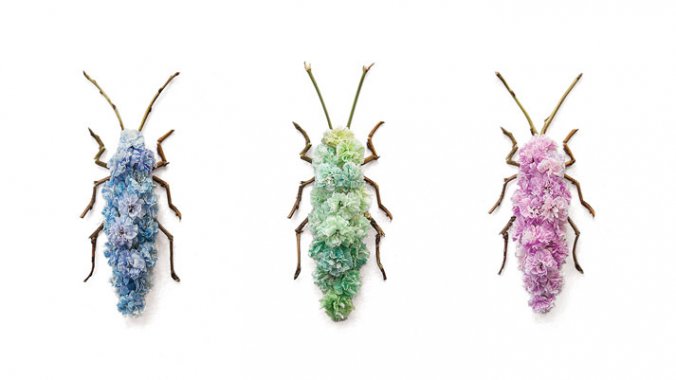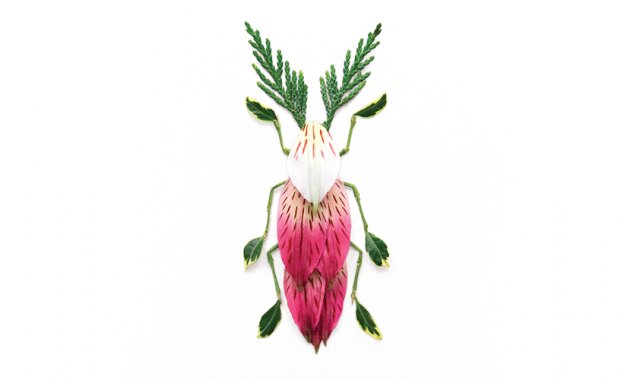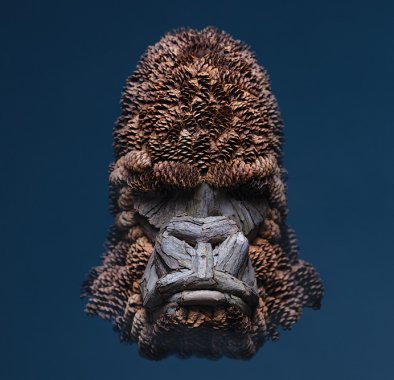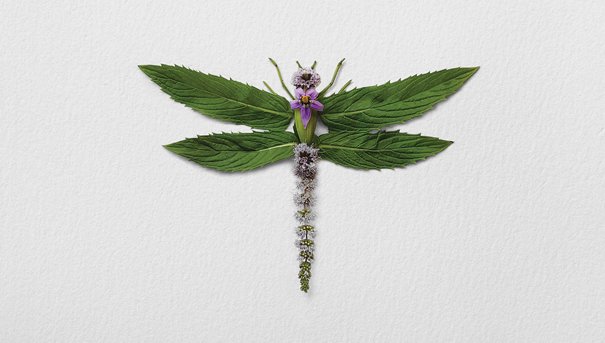From Flora to Fauna
From Flora to Fauna
Raku Inoue never really knew his grandfather, who died when he was very small. But every summer growing up, he’d travel from his home in Tokyo to visit his grandmother near Hiroshima. “She would open the door, and this dragonfly would come in,” he remembers. “She would say, ‘That’s your grandpa, reincarnated.’ ” Ever since, he has thought of insects as symbolic – even supernatural – beings.
Today, the 35-year-old makes his own magical insects out of plant fragments he gathers from his backyard in Montreal and elsewhere. His palm-sized flights of fancy delight the eye and imagination. A firefly with a buttercup bottom emits a glow of yellow dandelion petals; a stick-bug, the kind that mimics a branch to survive, is made of – well, a stick, with propeller seeds for wings. Naturally, Inoue has done a dragonfly, using bits of mint – a flowering sprig body, tiny stem legs, leaf wings – and a belladonna boutonniere.
Each insect embodies the colors and textures of a season. A stag beetle sports feathery finery of summer wildflowers and a single deep-blue hydrangea petal. A butterfly blazes in the fiery red and orange of fall foliage from northern Quebec. In winter come creatures crafted of conifer needles and pine cone scales, sometimes with translucent bodies made of ice. It melts, and that’s fine. Once Inoue completes an insect, he photographs it, then immediately adds it to a compost heap.
“This art is ephemeral, not meant to last,” he says of his pieces. “I sell them as prints. They just live their life, then go back to the earth. As human beings, we have a tendency to want to preserve things. I love my work, love what I do. But I feel true beauty comes from the liberty of letting it go.”
His natural hybrids are at once surreal and strikingly realistic. We recoil from a spider made of rose thorns and stems, even as we marvel at its ingenious design. A seedpod scorpion provokes a similar visceral shiver – and an equal admiration of its intricate construction. With all, there’s an odd sensation, not quite knowing where flora ends and fauna begins. “I take pleasure in merging both,” says Inoue. “This is how I see the world, where reality and fantasy blend and become this one thing.” Part of that, he acknowledges, comes from the sense of the bizarre and otherworldly that pervades the folklore and mythology of the land where he was born and raised. “Growing up in Japan,” he observes, “it’s hard not to have a fantastical mind.”
When Inoue was 9, he moved from Tokyo to Montreal with his mother, who worked as a translator, and her Canadian husband. He struggled at first to adapt to a new culture and learn both French, the official language of the province, and English. “My stepfather would translate my homework to my mother from French to English, and she would explain to me in Japanese,” he recalls. “It wasn’t fun.” Drawing became a means of escape. “I lived very much in a fantasy world, my cartoon world. I was always into visual things. Instead of reading the encyclopedia, I would look at the images and learn that way.” His teen years were, he says, “a dark time. I did heavy drugs. I was a frustrated kid, rebellious.” He quit high school and left home, working restaurant jobs to support himself.
When he was about 22, he went back to Japan. “It was my way of cleaning myself up, because I couldn’t get drugs there,” Inoue says candidly. He got a job on a farm, spending six months picking corn and digging potatoes. “It was physical and demanding. I was an introverted person, always overthinking inside. At some point, you have to just go into action,” he reflects. On a farm, “you start work when the sun comes up and go to bed when the sun goes down. That was exactly what I needed to have harmony of mind and body. It brought me back to my real self, made me realize happiness is something you have to sometimes earn.”
Feeling renewed, he came back to Montreal and enrolled at Collège Salette, a design school. Since leaving in 2010, he has worked on everything from graphic art, illustration, and photography for editorial and advertising clients to polymer clay sculpture, creative direction for music videos, and screenprinted apparel. “I’m like a chameleon,” he says of his multidisciplinary career.
A few years ago, he bought a house with a big backyard. “My mother always had a green thumb, this beautiful front yard with many flowers. I wanted to make something beautiful out of my backyard, so I started planting things.”
Inspired by the traditional Japanese art of ikebana, he made flower arrangements, then one day decided to try an insect shape. It became a creative exercise. “I would wake up in the morning, drink my coffee, do an insect, take a picture with my cell phone, and post it on Instagram.” His first series, a collection of nine insects in exuberant spring colors, went viral, bringing him media attention and commission offers. No longer just a hobby, the insects are now a mainstay of his practice.
Inoue surfs the web for insect silhouettes, selects his materials, and goes from there, letting nature inspire his choice of color, composition, and texture. “It’s like doing puzzles. You find the right piece, and then the right place for it.” He seldom uses glue, instead just putting it all together in an hour or so and taking the photo. “It’s like breathing now. There’s not much planning. I have the vision, and I create. That’s it.”
He’s experimenting with floral art pieces that are a little more permanent, using polymer clay. “The challenge is to marry plastic and natural materials in a harmonious way,” he says. Lately, he’s also venturing into three dimensions, sculpting animal busts: a conifer-needle tiger, a pine-cone gorilla, a tree-bark buffalo.
“Art, for me, is a channel through which I can express myself in a very free way,” says Inoue. “A lot of people say music saved them, or passion did, or love. Art is the same. We put our heart into it, and it fulfills us.”
